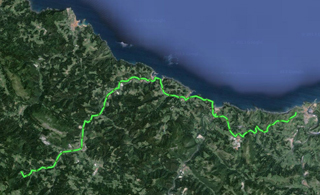 Today it is the summer solstice. This stage is shorter than it would be possible if we go by bike, since it would make sense to go up to Gernika at least, but I have decided to stay in Ziortza-Bolíbar, to spend the night at Zenarruza monastery inn, since my leg’s muscles ache and I find it difficult to go on normally.
Today it is the summer solstice. This stage is shorter than it would be possible if we go by bike, since it would make sense to go up to Gernika at least, but I have decided to stay in Ziortza-Bolíbar, to spend the night at Zenarruza monastery inn, since my leg’s muscles ache and I find it difficult to go on normally.
The first eleven kilometres are through internal forest trails, until we go towards the coast and get to Deba, from there, to Mutriku, to Ondarroa, and we get inland and do the last 20 km by mountain roads and tracks. I have to travel by roads because the conditions of the Way tracks are quite dangerous and terrible.
In Bolibar, when it is open, you can visit the museum devoted to Simón Bolívar, but I haven’t had the chance to see it yet because the opening times are weird and do not fit the tourist logic. Bolibar has a museum devoted to Bolívar because his father’s family was from this town. Zenarruza is a monastery located two kilometres from Bolibar, a quiet place, perfect to get some rest and for meditation.
Stage 24 in Wikiloc: http://en.wikiloc.com/wikiloc/view.do?id=4973495
GPS Track for Stage 24 download: http://goo.gl/ds0l8S
Distances: Albergue Santa Klara – Zenarruza Monastery 41 km
List of villages:

Download track 24 with QR BIDI
Zumaia
Itziar
Deba
Mutriku
Ondarroa
Markina-Xemein
Ziortza-Bolíbar
Zenarruza

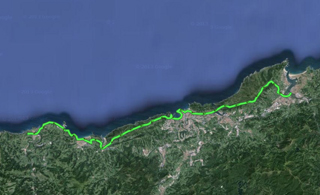 This is a classic stage of the Way of St. James, but avoids the sections which are not suitable for mountain bikes, and offers alternatives through forest trails and roads. Up to Pasaia, we go along paths and forest trails, with mild slopes, and in quite poor conditions due to the winter and spring rains. In Pasaia, we cross the sea inlet on a water taxi, and get to the end of Donostia through urban areas. From Donostia to Orio, we will go through forest trails, and from Orio to Zumaia, through coastal roads.
This is a classic stage of the Way of St. James, but avoids the sections which are not suitable for mountain bikes, and offers alternatives through forest trails and roads. Up to Pasaia, we go along paths and forest trails, with mild slopes, and in quite poor conditions due to the winter and spring rains. In Pasaia, we cross the sea inlet on a water taxi, and get to the end of Donostia through urban areas. From Donostia to Orio, we will go through forest trails, and from Orio to Zumaia, through coastal roads.
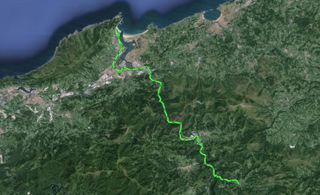 From Etxalar, I went to Bera de Bidasoa, and from there, I went down to the sea, to Hondarribia, to close the first section of the coast to coast trip. I got to the Atlantic Ocean through the Pyrenean Axis, after completing more than 1,000 km by mountain bike.
From Etxalar, I went to Bera de Bidasoa, and from there, I went down to the sea, to Hondarribia, to close the first section of the coast to coast trip. I got to the Atlantic Ocean through the Pyrenean Axis, after completing more than 1,000 km by mountain bike.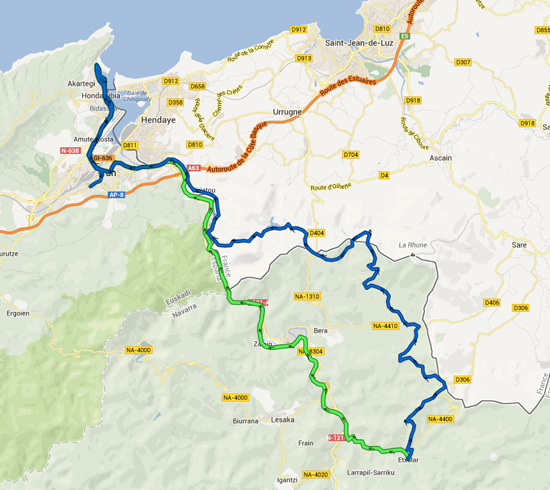

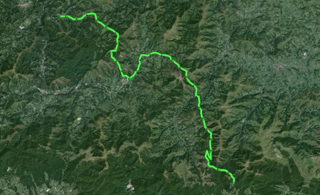 You leave Orreaga and go up a little mountain pass, Ibañeta, by road, before getting to a forest trail next to the shrine of San Salvador. From there, we will go down towards the valley of Aldudes, under French administration, in an endless and impressive descent.
You leave Orreaga and go up a little mountain pass, Ibañeta, by road, before getting to a forest trail next to the shrine of San Salvador. From there, we will go down towards the valley of Aldudes, under French administration, in an endless and impressive descent.
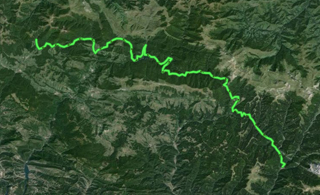 The first part of this stage is by road. You go up two mountain passes, of progressive difficulty, until you get to a high point of 1,300 m. In this point, you start moving along the forest trail, and you enter the natural park of the Irati rainforest, the biggest forest in Navarre. Almost a third of the stage is done in Irati, and it is a spectacular landscape. When you go out of Irati, you follow village roads to the weapons factory of Orbaizeta, and from there, you go up forest trails to Orreaga.
The first part of this stage is by road. You go up two mountain passes, of progressive difficulty, until you get to a high point of 1,300 m. In this point, you start moving along the forest trail, and you enter the natural park of the Irati rainforest, the biggest forest in Navarre. Almost a third of the stage is done in Irati, and it is a spectacular landscape. When you go out of Irati, you follow village roads to the weapons factory of Orbaizeta, and from there, you go up forest trails to Orreaga.
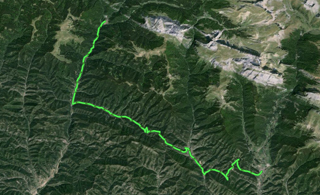 Today, I have also decided to travel by road. This is because I would like to pass by Roncal, and if I follow the Trans Pyrenees route, when I arrive in Ansó, I will have to divert northward and enter Navarre from another site.
Today, I have also decided to travel by road. This is because I would like to pass by Roncal, and if I follow the Trans Pyrenees route, when I arrive in Ansó, I will have to divert northward and enter Navarre from another site.
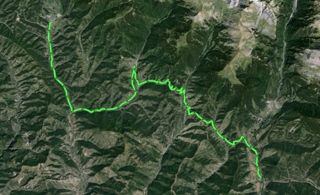 This stage leads to Aragüés by a mountain road, so the classic Transpyrenean Route is not altered, but I’ve made a minor variation from Aragüés, since I am following the advice given to me by people who know the area I would have to pass by and who have told me the conditions of the paths are disastrous. I have changed the planned trip and gone by route from Castiello to Hecho, where there is a campsite, instead of reaching Navarre via Urdués.
This stage leads to Aragüés by a mountain road, so the classic Transpyrenean Route is not altered, but I’ve made a minor variation from Aragüés, since I am following the advice given to me by people who know the area I would have to pass by and who have told me the conditions of the paths are disastrous. I have changed the planned trip and gone by route from Castiello to Hecho, where there is a campsite, instead of reaching Navarre via Urdués.
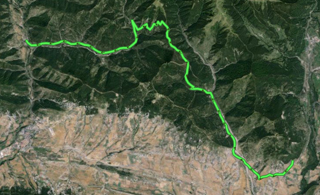 Today’s stage was shorter than I had planned, since I wanted to reach Aragüés del Puerto, but I ended up in Castiello, 18 km away from Aragüés, but the closest point with a campsite.
Today’s stage was shorter than I had planned, since I wanted to reach Aragüés del Puerto, but I ended up in Castiello, 18 km away from Aragüés, but the closest point with a campsite.
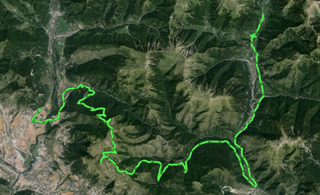 From Torla to Fiscal, you go by road, a section that is about 20 km long and is completed quickly, but one of the hardest stages of the whole Trans Pyrenees Route starts in Fiscal. The main reason is the conditions of the forest trails, which are very damaged by the effects of winter.
From Torla to Fiscal, you go by road, a section that is about 20 km long and is completed quickly, but one of the hardest stages of the whole Trans Pyrenees Route starts in Fiscal. The main reason is the conditions of the forest trails, which are very damaged by the effects of winter.
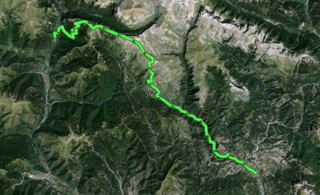 I had to stay in the campsite for three days because it didn’t stop raining. It is an atypical June: it rains every day and it is pretty cold, which keeps the snow on the hulls during mid-June. The water build-up begins to be noticeable in the Pyrenees, since it has made the river level to go up, and there already are some permanent alerts by the Civil Defence services. Important floods are starting to strike in the Catalonian Pyrenees.
I had to stay in the campsite for three days because it didn’t stop raining. It is an atypical June: it rains every day and it is pretty cold, which keeps the snow on the hulls during mid-June. The water build-up begins to be noticeable in the Pyrenees, since it has made the river level to go up, and there already are some permanent alerts by the Civil Defence services. Important floods are starting to strike in the Catalonian Pyrenees.